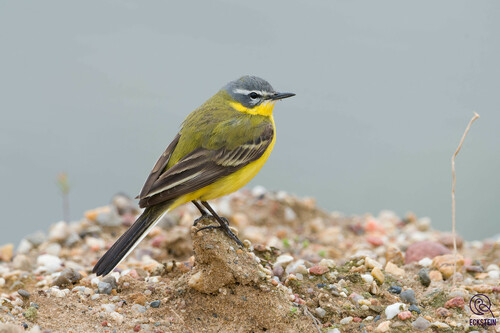
Western Yellow Wagtail
The Western Yellow Wagtail (Motacilla flava) is a small, slender passerine bird known for its vibrant yellow underparts and lively behavior. It plays a significant role in controlling insect populations across its wide breeding range. This species is a highly migratory bird, traversing vast distances between its breeding grounds in Eurasia and its wintering grounds in Africa and South Asia. While not currently considered globally threatened, localized populations face challenges from habitat loss and agricultural intensification. The Western Yellow Wagtail has little significant cultural importance, although it has been referenced in some literary works.
15-16 cm
Length
23-27 cm
Wingspan
Least Concern
Conservation Status
Distribution
Breeds across much of Europe and Asia, from the British Isles and Iberia eastward to Siberia and parts of Central Asia. Migrates south to sub-Saharan Africa, the Indian subcontinent, and Southeast Asia for the winter. Altitudinal range varies from sea level to high-altitude meadows.
Lifespan
Typical lifespan in the wild is 2-3 years, though some individuals may live longer.
Western Yellow Wagtail's Habitat
Habitat Types
Open grasslands, Wet meadows, Marshes, Agricultural fields (especially pastures), Tundra edges
Climate Zones
Temperate, Boreal, Subarctic, Mediterranean
Adaptations
Long legs and claws are adapted for walking and running on the ground in open habitats. Their slender bill is well-suited for picking insects from the ground or vegetation.
Variations
Numerous subspecies exist (around 10-15 are commonly recognized), differing primarily in head plumage patterns of breeding males. Examples include *M. f. flava* (Blue-headed Wagtail) and *M. f. flavissima* (Yellow Wagtail).
Appearance
Breeding Plumage
Breeding males have bright yellow underparts and varying head patterns depending on the subspecies. Non-breeding males and females have duller yellow or yellowish-buff underparts and less distinct head patterns.
Seasonal Feather Changes
Plumage is brightest during the breeding season. After molting, birds become duller for the non-breeding season.
Sex Based Plumage Differences
Males are generally brighter and more distinctly patterned than females, particularly during the breeding season.
Notable Features
Long, constantly wagging tail, Slender body shape, Bright yellow underparts (especially in breeding males)
Diet and Feeding
Primary Foods
Insects, Spiders, Small invertebrates
Foraging Behavior
Forages primarily on the ground, walking or running to pick up prey. Often found near grazing animals, where insects are disturbed. May also catch insects in flight.
Specializations
Agile movements and sharp eyesight aid in capturing small, fast-moving prey.
Seasonal Diet Variations
Diet may shift slightly depending on insect availability, with more variety during the breeding season when insects are abundant.
Behavior
Social Structure
Generally found in pairs or small family groups during the breeding season. Forms larger flocks during migration and in wintering areas.
Communication
Variety of calls, including a distinctive 'tsweep' flight call, Song is a simple, repetitive series of notes, Tail wagging is a common visual signal
Migration
Long-distance migrant, with complex routes and timing. European populations generally migrate to sub-Saharan Africa, while Asian populations migrate to South and Southeast Asia. Migration is triggered by changes in day length and food availability.
Territorial or Group Behaviors
Males defend breeding territories, but territoriality is less pronounced during the non-breeding season. Forms communal roosts in wintering areas.
Conservation
Threats
Habitat loss (due to agricultural intensification and drainage of wetlands), Pesticide use (reducing insect prey), Climate change (affecting breeding and migration patterns)
Protection Programs
Some protection under national and international legislation (e.g., the EU Birds Directive), Habitat restoration and management projects in some areas
Local National Laws
Protected under various national laws across its range.
Population Trend
Stable overall, but some populations are declining.
Population Estimates
Global population estimated to be in the millions, but precise numbers are difficult to determine.
Interesting Facts
The Western Yellow Wagtail has many different subspecies.
Each one with unique characteristics and breeding ranges.
The constant tail-wagging is a characteristic behavior
Although the exact reason for this is not fully understood.
They are highly migratory birds
Traveling thousands of kilometers between breeding and wintering grounds.
They often associate with grazing livestock
Taking advantage of the insects disturbed by the animals.
Faqs about Western Yellow Wagtail
Why do wagtails wag their tails?
The exact reason is not fully known, but it may be related to communication, flushing out prey, or maintaining balance.
Where do Western Yellow Wagtails go in winter?
They migrate to sub-Saharan Africa, the Indian subcontinent, and Southeast Asia.
What do Western Yellow Wagtails eat?
They primarily eat insects, spiders, and other small invertebrates.
Are Western Yellow Wagtails endangered?
No, they are classified as 'Least Concern' by the IUCN, but some local populations are declining due to habitat loss and other threats.
How many subspecies are there?
There are many recognized subspecies, with estimates ranging from 10-15, distinguished by differences in male breeding plumage.
Copyright @ Nature Style Limited. All Rights Reserved.
 English
English